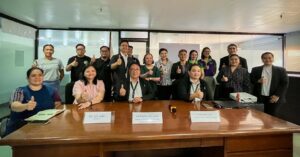The Library’s core roles remain constant

- In the pandemic the digital services has proven as the library’s lifeline, the principal way to reach out to the community and help them with their needs.
- This article describes the state of digital libraries and online services of libraries in the Philippines, and their response to the COVID-19 pandemic
Note: This article was originally published on goethe.de/emerginginternationalvoices. Allana S. Delgado was selected as one of the 19 Emerging International Voices, a joint project of International Federation of Library Associations and Institutions (IFLA) and Goethe-Institut. Its long-term purpose is to establish an international network of young individuals engaged in library advocacy in their countries.
Nowadays, libraries have no choice but to go online. A library without any sort of online presence would be considered outdated. Digital services in any library are a must, especially at this time of rapid information access. More people are relying on the online delivery of goods, services, and of course, information.
Most libraries have their collections accessible online in repositories, digital libraries, and online public access catalogues (OPACs). Aside from access to library resources, digital services are also a means for libraries to reach their users. Social media, email, instant messaging, websites, and other electronic means have been used by libraries to promote their services and reach out to their community.
Digital services have long been embraced by Philippine libraries. Innovations usually come from the community of academic libraries. As early as the 2000s, major universities in the capital region of Metro Manila have adopted online reference services (Ramos and Abrigo, 2011).
Common digital services include online public access catalogues, online indexes, bibliographic and online databases. In reference services, popular platforms used by libraries include Facebook, social media, instant messaging, email, web forms, and ‘ask a Librarian’ services.
Many libraries still rely on face-to-face interaction as the main component of service. However, this year, the COVID-19 pandemic has affected libraries. Physical distancing measures and other health protocols were imposed by the government. From March 2020 until the present, lockdowns and community quarantines in the Philippines were implemented, which led libraries to close temporarily. Those libraries that have reopened have to follow guidelines to mitigate the spread of the virus.
Libraries in the school and academic communities have also been affected. Most schools have adapted to online learning, which brought a new challenge to libraries and librarians: how do we deliver services when our users can no longer access the library physically? Many libraries have already established digital services, while there are also libraries with none or those whose services might need to improve to adapt to the changes.
There are also libraries in the Philippines with their digital resources available online such as the Southeast Asian Fisheries Development Center – Aquaculture Department (SEAFDEC AQD) Library; Philippine Council for Agriculture, Aquatic and Natural Resources Research and Development (PCAARRD) digital library; Filipinas Heritage Library; the National Library; and others. These libraries have an advantage as all or part of their collections can be accessed online. Most academic libraries also subscribe to online resources. However, not all libraries have extensive digital collections.
Due to the lockdown, many libraries link to and curate open access resources on their websites and platforms that users can access remotely. There are vast quantities of information on the internet, but the average user may be confused and overwhelmed. The librarian as a professional who can distinguish quality information is a big help in this regard, and can teach users how to select the right sources.
There are vast quantities of information on the internet, but the average user may be confused and overwhelmed. The librarian as a professional who can distinguish quality information is a big help in this regard, and can teach users how to select the right sources.
In my own experience as a librarian at Central Philippine University, the Henry Luce III Library already had an online presence: a website, OPAC, online databases, and a Facebook page. However, the website was not up to date and the Facebook page was inactive. The marketing of the online databases was also inadequate. Since the services in the physical library were good enough for the community, enhancing the digital side of services had not been a priority. That changed due to COVID-19.
When the long lockdown from March to May 2020 was lifted, the library faced a new challenge, shared by libraries all over the country. Libraries and librarians are not highly valued by the public and many have questioned why libraries need to be open at all. In my university, students have asked why they still needed to pay a library fee if the library is closed to the public. We also had to prove to the university administration that the library could still function – that the library may even be more relevant during the pandemic.
In a short time, the library established its own digital services. New services had to be implemented: virtual reference services, document delivery, scanning, email, and a chat service. The website and Facebook page also had to be improved. Since the library also had young and tech-savvy staff and librarians, it was possible to tap into skills that they hadn’t previously used in the library setting.
Since the library also had young and tech-savvy staff and librarians, it was possible to tap into skills that they hadn’t previously used in the library setting.
The virtual reference services were launched, along with a revamped Facebook page and improved website. The Facebook page has expanded its content to promote the library and its services, link to online resources, and reach out to the university community. This was used as the community – especially the college and high school students – is active on social media. The page’s followers have grown from fewer than 2,000 in June 2020 to almost 5,500 at the time of writing. As for the new chat service, the library receives questions and requests daily from students, faculty, staff, alumni, and external researchers. Though there are still many challenges ahead for us in the digital realm, we have definitely had a good start.
More useful content is planned for the website and it now features a blog with the latest news and events that the library is involved in. The library is also planning to expand onto further social media and online platforms in the future.
Many other libraries have followed suit and established or improved their own digital services. The pandemic is challenging, but digital services are the library’s lifeline, as the principal way we can reach out to the community and help them with their needs. Even with limited physical access and ever-evolving technology, the library’s core roles remain constant: to organize and provide access to information; and to help its community.
References:
Ramos, M.S. and Abrigo, C.M. (2012), “Reference 2.0 in action: an evaluation of the digital reference services in selected Philippine academic libraries”, Library Hi Tech News, Vol. 29 No. 1, pp. 8-20. doi.org/10.1108/07419051211223426
Copyright: Text: Goethe-Institut, Allana S. Delgado. This work is licensed under a Creative Commons Attribution 4.0 license.









